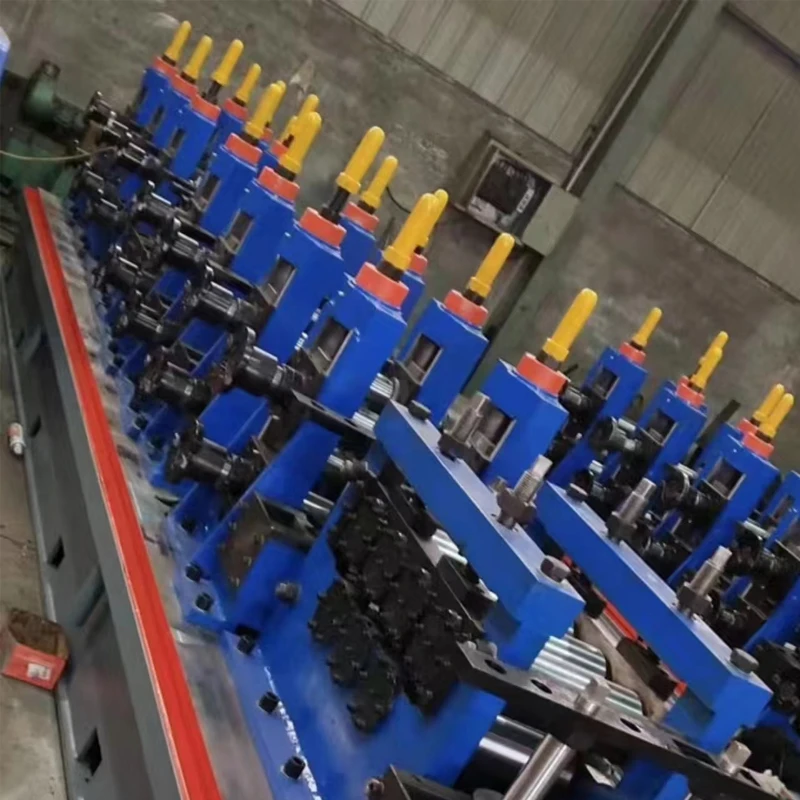Understanding the Essentials of Roll Forming Machine Die Design and Functionality
Understanding Roll Forming Machine Dies Key Components and Their Importance
Roll forming is a continuous bending operation in which a long strip of metal is fed through a series of rollers to create a desired cross-sectional profile. This process is used in various industries to manufacture components such as automotive parts, building materials, and appliances. At the heart of the roll forming process are the dies, which play a crucial role in determining the efficiency, accuracy, and overall quality of the final product. In this article, we will explore the significance of roll forming machine dies, their types, and best practices for maintenance and design.
What Are Roll Forming Machine Dies?
Roll forming machine dies are specialized tools made from high-strength materials designed to shape metal as it passes through the rollers. These dies are responsible for defining the geometry of the metal profile and ensuring that it maintains dimensional accuracy throughout the forming process. The design of dies is pivotal, as it directly affects the mechanical properties of the resultant profiles, including their strength, flexibility, and durability.
Types of Roll Forming Dies
There are several types of dies used in the roll forming process, each tailored for specific applications
1. Flat Dies These dies are basic and used for creating simple flat profiles. They are typically employed in applications where minimal shaping is required.
2. Profile Dies More complex than flat dies, profile dies are used to create intricate shapes and structures. These dies can produce components like brackets, frames, and channels that are often found in construction and manufacturing.
3. Box Dies These dies are specifically designed to form hollow sections, such as tubes or boxes. They require precision to maintain uniform wall thickness while ensuring structural integrity.
roll forming machine die

4. Custom Dies In many cases, a specific project may require a unique design that does not fit existing categories. Custom dies are engineered to meet particular specifications, ensuring optimal performance for specialized applications.
Importance of Die Design and Engineering
The design and engineering of roll forming dies are critical. Factors such as material selection, heat treatment, and surface finishing can significantly influence the performance and lifespan of the dies. High-speed steel or carbide materials are often preferred due to their durability and resistance to wear. Furthermore, advanced engineering techniques, like CAD modeling, are regularly employed to optimize die design for precision and efficiency.
Maintenance and Care of Roll Forming Dies
Proper maintenance of roll forming machine dies is essential to ensure longevity and consistent performance. Regular inspections should be performed to identify signs of wear, such as cracks or deformation. Keeping the dies clean is equally important, as debris buildup can lead to product defects and increased downtime for repairs.
Lubrication also plays a vital role in the maintenance of dies. Proper lubrication reduces friction, minimizes wear, and prevents overheating during the rolling process. It is advisable to follow the manufacturer's recommendations regarding lubrication intervals and types.
Conclusion
Roll forming machine dies are integral to the roll forming process, influencing the quality, accuracy, and efficiency of the final product. From basic flat dies to complex custom designs, each type serves a specific purpose and requires meticulous engineering to achieve optimal results. The importance of regular maintenance cannot be overstated; attentive care prolongs the life of the dies and ensures the consistent performance of the roll forming machine.
As industries continue to evolve and demand more intricate and high-quality components, understanding the role of roll forming machine dies will become even more critical. Manufacturers and engineers must invest time and resources in die design, maintenance, and innovation to stay competitive in an ever-advancing market. By recognizing the vital importance of these components, businesses can ensure they produce top-notch products that meet industry standards and customer expectations.
-
Top Straightening Machine Supplier – High Precision Solutions for Metal ProcessingNewsJun.10,2025
-
High Efficiency Rotary Shear Machine for Precision Cutting Versatile Rotary Shear Shredder & Cordless OptionsNewsJun.10,2025
-
High-Precision Cold Rolled Steel Machine for Quality ProductionNewsJun.09,2025
-
Metal Tube Making Machine – High Precision & AutomationNewsJun.09,2025
-
Automated Lami Tube Manufacturing Machine High Output & PrecisionNewsJun.09,2025
-
Premium Roll Forging Machines High-Precision Metal Forming SolutionsNewsJun.09,2025


